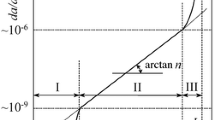Abstract
The fatigue crack growth model proposed by Frost and Dixon, based on the different crack tip geometries of a loaded and unloaded crack, is restated and extended using the stress intensity factor concept. The resulting crack growth predictions agree reasonably well both with experimental fatigue crack growth data, and data on the threshold stress necessary for fatigue crack growth.
Résumé
Le modèle de propagation des fissures de fatigue proposé par Frost et Dixon, qui repose sur les différences de géométrie de l'extrémité d'une fissure selon que celle-ci est sous contrainte ou déchargée, est reformulé et étendu, en utilisant le concept de facteur d'intensité de contrainte.
Les prédictions de propagation de fissure qui résultent de cette nouvelle expression sont en bon accord avec les données expérimentales de propagation des fissures en fatigue, ainsi qu'avec la valeur critique de la contrainte, nécessaire pour que cette propagation ait lieu.
Zusammenfassung
Das von Frost und Dixon vorgeschlagene Modell der Fortpflanzung von Ermüdungsrissen, welches auf den Unterschieden in der Geometrie einer belasteten und einer nicht belasteten Probe beruht, wird unter Hinzuziehen des Begriffs des Spannungsintensitätsfaktors neu formuliert und erweitert.
Die sich aus dieser neuen Formulierung ergebenden Voraussagen stehen in guter Übereinstimmung mit den experimentellen Werten, welche für das Fortschreiten von Ermüdungsrissen und die für die Fortpflanzung des Risses erforderliche kritische Belastung ermittelt wurden.
Similar content being viewed by others
References
W. F. Brown and J. E. Srawley, Plane strain crack toughness testing of high strength metallic materials, ASTM STP 410, Philadelphia, Pa: American Society for Testing and Materials (1966).
J. E. Srawley and W. F. Brown, Fracture toughness testing, ASTM (in co-operation with NASA), Symp. on fracture toughness testing and its applications, ASTM STP 381, pp. 133–198, Philadelphia, Pa: American Society for Testing and Materials (1965).
P. C. Paris and G. C. Sih, Stress analysis of cracks, ASTM (in co-operation with NASA), Symp. on fracture toughness testing and its application, ASTM STP 381, pp. 30–83, Philadelphia, Pa: American Society for Testing and Materials (1965).
N. E. Frost and J. R. Dixon, A theory of fatigue crack growth, Int. J. Fracture Mech., 3, 4 (1967) 301–316.
N. E. Frost, L. P. Pook and K. Denton, A fracture mechanics analysis of fatigue crack growth data for various materials, Engng. Fracture Mech., 3, 2 (1971) 109–126.
L. P. Pook, Discussion of “On the sharpness of cracks compared with Well's COD”, by J. E. Srawley, J. L. Swedlow and E. Roberts, Jr., Int. J. Fracture Mech., 7, 1 (1971) 125–126.
M. Creager and P. C. Paris, Elastic field equations for blunt cracks with reference to stress corrosion cracking, Int. J. Fracture Mech., 4, 3 (1967) 247–252.
J. R. Rice, Mechanics of crack tip deformation and extension by fatigue, Fatigue Crack Propagation, ASTM STP 415, pp. 247–309, Philadelphia, Pa: American Society for Testing and Materials (1967).
L. P. Pook, The effect of crack angle on fracture toughness, Engng. Fracture Mech., (to be published.)
N. E. Frost, The growth of fatigue cracks, First Int. Conf. on Fracture, Sendai, 3 (1965) 1433–1459.
N. E. Frost, Effect of mean stress on the rate of growth of fatigue cracks in sheet materials, J. Mech. Engng. Sci., 4, 1 (1962) 22–35.
L. P. Pook, Effect of hardness and tensile mean stress on fatigue crack growth in beryllium copper, J. Mech. Engng. Sci., 11, 3 (1969) 343–345.
P. C. Paris, Testing for very slow growth of fatigue cracks, Closed Loop, 2, 5 (1970) 11–14.
H. H. Johnson and P. C. Paris, Sub-critical flaw growth, Engng. Fracture Mech., 1, 1 (1968) 3–45.
K. J. Marsh, Unpublished results.
A. F. Greenan, NEL Report (in preparation).
Author information
Authors and Affiliations
Rights and permissions
About this article
Cite this article
Pook, L.P., Frost, N.E. A fatigue crack growth theory. Int J Fract 9, 53–61 (1973). https://doi.org/10.1007/BF00035955
Received:
Issue Date:
DOI: https://doi.org/10.1007/BF00035955




